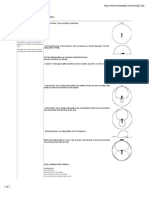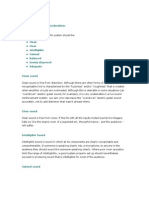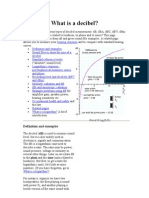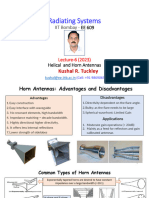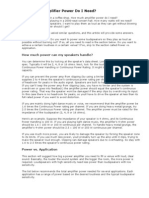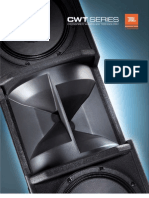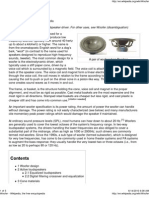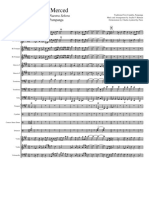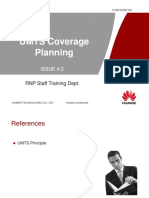Speaker)
Speaker)
Uploaded by
inhinyerokinoCopyright:
Available Formats
Speaker)
Speaker)
Uploaded by
inhinyerokinoCopyright
Available Formats
Share this document
Did you find this document useful?
Is this content inappropriate?
Copyright:
Available Formats
Speaker)
Speaker)
Uploaded by
inhinyerokinoCopyright:
Available Formats
Southern Luzon State University College of Engineering ECE Department
DESIGN OF A SPEAKER ECE 12L - Broadcast and Acoustics
Submitted by: GROUP 5 Dalisay, Christi Norma C. Dela Carzada, JP Guano, Kenneth P. Guardino, Roan V. Guinto, Lyka Melissa A. BSECE VA
Submitted to: Engr. Renante D. Abuyan Instructor
October 20, 2011
I. -
Objectives To be able to design a speaker with tweeter, midrange and base.
II.
Discussion
A loudspeaker (or "speaker") is an electro acoustic transducer that produces sound in response to an electrical audio signal input. Non-electrical loudspeakers were developed as accessories to telephone systems, but electronic amplification by vacuum tube made loudspeakers more generally useful. The most common form of loudspeaker uses a paper cone supporting a voice coil electromagnet acting on a permanent magnet, but many other types exist. Where accurate reproduction of sound is required, multiple loudspeakers may be used, each reproducing a part of the audible frequency range. Miniature loudspeakers are found in devices such as radio and TV receivers, and many forms of music players. Larger loudspeaker systems are used for music, sound reinforcement in theatres and concerts, and in public address systems. Driver types Individual electrodynamic drivers provide optimal performance within a limited pitch range. Multiple drivers (e.g., subwoofers, woofers, mid-range drivers, and tweeters) are generally combined into a complete loudspeaker system to provide performance beyond that constraint. Full-range drivers A full-range driver is designed to have the widest frequency response possible. These drivers are small, typically 3 to 8 inches (7.6 to 20 cm) in diameter to permit reasonable high frequency response, and carefully designed to give low-distortion output at low frequencies, though with reduced maximum output level. Full-range (or more accurately, wide-range) drivers are most commonly heard in public address systems, in televisions (although some models are suitable for hi-fi listening), small radios, intercoms, some computer speakers, etc. In hi-fi speaker systems, the use of wide-range drive units can avoid undesirable interactions between multiple drivers caused by non-coincident driver location or crossover network issues. Fans of wide-range driver hi-fi speaker systems claim a coherence of sound, said to be due to the single source and a resulting lack of interference, and likely also to the lack of crossover components. Detractors typically cite wide-range drivers' limited frequency response and modest output abilities (most especially at low frequencies), together with their requirement for large, elaborate, expensive enclosuressuch as transmission lines, or hornsto approach optimum performance. Full-range drivers often employ an additional cone called a whizzer: a small, light cone attached to the joint between the voice coil and the primary cone. The whizzer cone extends the high-frequency response of the driver and broadens its high frequency directivity, which would otherwise be greatly narrowed due to the outer diameter cone material failing to keep up with the central voice coil at higher frequencies. The main cone in a whizzer design is manufactured so as to flex more in the outer diameter than in the center. The result is that the main cone delivers low frequencies and the whizzer cone contributes most of the higher
frequencies. Since the whizzer cone is smaller than the main diaphragm, output dispersion at high frequencies is improved relative to an equivalent single larger diaphragm. Limited-range drivers, also used alone, are typically found in computers, toys, and clock radios. These drivers are less elaborate and less expensive than wide-range drivers, and they may be severely compromised to fit into very small mounting locations. In these applications, sound quality is a low priority. The human ear is remarkably tolerant of poor sound quality, and the distortion inherent in limited-range drivers may enhance their output at high frequencies, increasing clarity when listening to spoken word material. Subwoofer A subwoofer is a woofer driver used only for the lowest part of the audio spectrum: typically below 200 Hz for consumer systems below 100 Hz for professional live sound and below 80 Hz in THX-approved systems. Because the intended range of frequencies is limited, subwoofer system design is usually simpler in many respects than for conventional loudspeakers, often consisting of a single driver enclosed in a suitable box or enclosure. To accurately reproduce very low bass notes without unwanted resonances (typically from cabinet panels), subwoofer systems must be solidly constructed and properly braced; good speakers are typically quite heavy. Many subwoofer systems include power amplifiers and electronic sub-filters, with additional controls relevant to low-frequency reproduction. These variants are known as "active subwoofers". In contrast, "passive" subwoofers require external amplification. Woofer A woofer is a driver that reproduces low frequencies. The driver combines with the enclosure design to produce suitable low frequencies (see speaker enclosure for the design choices available). Some loudspeaker systems use a woofer for the lowest frequencies, sometimes well enough that a subwoofer is not needed. Additionally, some loudspeakers use the woofer to handle middle frequencies, eliminating the mid-range driver. This can be accomplished with the selection of a tweeter that can work low enough that, combined with a woofer that responds high enough, the two drivers add coherently in the middle frequencies. Mid-range driver A mid-range speaker is a loudspeaker driver that reproduces middle frequencies. Mid-range driver diaphragms can be made of paper or composite materials, and can be direct radiation drivers (rather like smaller woofers) or they can be compression drivers (rather like some tweeter designs). If the mid-range driver is a direct radiator, it can be mounted on the front baffle of a loudspeaker enclosure, or, if a compression driver, mounted at the throat of a horn for added output level and control of radiation pattern. Tweeter A tweeter is a high-frequency driver that reproduces the highest frequencies in a speaker system. Many varieties of tweeter design exist, each with differing abilities with regard to frequency response, output fidelity, power handling, maximum output level, etc. Softdome tweeters are widely found in home stereo systems, and horn-loaded compression
drivers are common in professional sound reinforcement. Ribbon tweeters have gained popularity in recent years, as their output power has been increased to levels useful for professional sound reinforcement, and their output pattern is wide in the horizontal plane, a pattern that has convenient applications in concert sound. Coaxial drivers A coaxial driver is a loudspeaker driver with two or several combined concentric drivers. Coaxial drivers have been produced by many companies, such as Altec, Tannoy, Pioneer, KEF, BMS, Cabasse and Genelec. Specifications Speaker or driver type (individual units only) Full-range, woofer, tweeter, or mid-range. Size of individual drivers. For cone drivers, the quoted size is generally the outside diameter of the basket. However, it may less commonly also be the diameter of the cone surround, measured apex to apex, or the distance from the center of one mounting hole to its opposite. Voice-coil diameter may also be specified. If the loudspeaker has a compression horn driver, the diameter of the horn throat may be given. Rated Power Nominal (or even continuous) power, and peak (or maximum short-term) power a loudspeaker can handle (i.e., maximum input power before destroying the loudspeaker; it is never the sound output the loudspeaker produces). A driver may be damaged at much less than its rated power if driven past its mechanical limits at lower frequencies. Tweeters can also be damaged by amplifier clipping (amplifier circuits produce large amounts of energy at high frequencies in such cases) or by music or sine wave input at high frequencies. Each of these situations passes more energy to a tweeter than it can survive without damage. In some jurisdictions, power handling has a legal meaning allowing comparisons between loudspeakers under consideration. Elsewhere, the variety of meanings for power handling capacity can be quite confusing. Impedance typically 4 (ohms), 8 , etc. Baffle or enclosure type (enclosed systems only) Sealed, bass reflex, etc. Number of drivers (complete speaker systems only) two-way, three-way, etc. and optionally: Crossover frequency (ies) (multi-driver systems only) The nominal frequency boundaries of the division between drivers. Frequency response The measured, or specified, output over a specified range of frequencies for a constant input level varied across those frequencies. It sometimes includes a variance limit, such as within " 2.5 dB". Thiele/Small parameters (individual drivers only) these include the driver's Fs (resonance frequency), Qts (a driver's Q; more or less, itsdamping factor at resonant frequency), Vas (the equivalent air compliance volume of the driver), etc.
Sensitivity The sound pressure level produced by a loudspeaker in a non-reverberant environment, often specified in dB and measured at 1 meter with an input of 1 watt (2.83 rms volts into 8 ), typically at one or more specified frequencies. This rating is often specified by manufacturers to be impressive. Maximum SPL The highest output the loudspeaker can manage, short of damage or not exceeding a particular distortion level. This rating is often specified by manufacturers to be impressive, and is commonly given without reference to frequency range or distortion level.
I.
Latest Model and Brands
Brand Name Model Number Channels Player Type Place of Origin Color Materials Finished Use Payment & Shipping Terms: Price:
OEM HT-8620 5.1 DVD Player Guangdong, China (Mainland) Black;silver MDF Wood painting home theater
FOB USD 50~120 / Set Get Latest Price
Minimum Order Quantity: Port: Packaging Details:
100 Set/Sets guangzhou 2cartons
Delivery Time: Payment Terms:
20days L/C,T/T,Western Union
Brand Name Model Number Channels Player Type Special Feature Place of Origin USE Payment & Shipping Terms: Price: Minimum Order Quantity: Port: Packaging Details: Delivery Time: Payment Terms: Supply Ability:
OEM 4455 5.1 DVD Player Wireless System Guangdong, China (Mainland) home theater ,karaoke
Get Latest Price 200 Set/Sets guangzhou 2 pack/ 1set within 20-25days L/C,T/T,Western Union 20000 Set/Sets per Month
I.
Parts Identification and Functions
1. The Cone expands the area swept by the movement of the voice coil. A 2 voice coil can be attached to many different cone sizes depending on the purpose of the speaker.The ideal cone is light, strong, and well dampened. If the cone is too heavy it will be slow to respond to the movement of the voice coil. If the cone is weak it will flex or bend. If the cone is not well dampened it will color the sound with harmonics or resonances. Many cones are made from types of treated paper. 2. The Dust Cap is a small dome (or inverted dome) over the middle of the cone. Underneath it lays the center of the voice coil former and the pole piece. The dust cap keeps harmful things from entering the speakers internals and damaging them. If anything solid gets into the gap its game over for your speaker.. 3. The Surround - attaches the top of the cone to the basket. This also seals the front of the cone from the rear. Surrounds are usually made of butyl rubber, foam, or sometimes cloth. 4. The Basket holds all of the speakers parts together and gives them something to mount to. Additionally, the basket also offers a flange to allow the speaker to be mounted to a baffle of some kind. 5. The Spider in this case does not have eight legs and spin webs. This is a device that centers the moving parts of the speaker. Usually made from cotton, it allows the moving parts to move in and out but not side to side. Without a spider the speakers movement would be uncontrolled and it would easily destroy itself. 6. The Motor Structure is a general term referring to the sum of the lower parts of the speaker that produce motion. This includes the magnet, pole piece and the gap. The gap is the area around the pole piece between it and the magnet. The voice coil fits into this very small area. This is centered between the north and south poles of the magnets magnetic field. 7. The Pole Piece acts as a guide for the voice coil former to move in and out. 8. The Voice Coil and Former are a single unit. The former is a cylinder that the voice
9. coil is wound around. It is attached to the back of the cone so that when the voice coil is moved the cone moves as well. The voice coil is a coil of wire that changes its polarity when electric current is run through it. The coil, at rest, sits between the magnets polar north and south. When its polarity changes it repels the polarity of the magnet and moves. 10. The Magnet creates a magnetic field (surprising I know) around the gap. This field causes the voice coil to move when it is charged. There are two types of common magnets used in speakers. The most common ones are ferrite magnets, which are quite heavy and will loose their magnetism over time and if they are dropped. Neodymium magnets are the most powerful permanent magnets and weigh a lot less than ferrite magnets. This makes them perfect for car audio applications where lower reducing weight is always a goal. 11. The Terminals are where you connect your signal wires to the speaker. These wires come directly from the amplifier. There will be a positive and a negative terminal for each voice coil that the speaker has. The subwoofer pictured above has two voice coils and has another pair of terminals on the other side of the speaker. 12. The Tinsel Leads are the wires connect the terminals to the voice coil. These are sometimes woven into the spider to prevent noise. I. The Design
This shows the math involved in selecting the proper coil for the speaker system. This is the formula needed:
Impedance = The rated impedance of the speaker Pi=3.14.... Frequency = The desired 3dB down (crossover) point Inductor = Value of proper coil - value given in henries (multiply by 1000 to convert to millihenries) For this example, let's choose 8 ohms as the speaker's rated impedance. We will use 200hz as the desired crossover point. Value of the coil=8/(2*3.14*200) Value of the coil=6.37 milihenriess
This section shows the math involved in selecting the proper capacitor for your particular speaker system. This is the formula needed.
Impedance = the rated impedance of the speaker Pi=3.14.... Frequency = the desired 3dB down (crossover) point Capacitor = Value of proper capacitor - value given in farads (multiply by 1,000,000 to convert to microfarads) For this example, let's choose 8 ohms as the speaker's rated impedance. We will use 1200 Hz as the desired crossover point. Value of the capacitor=1/(2*3.14*1200*8) Value of the capacitor=16.6 microfarads Capacitors must be non-polar types with a voltage rating of 50V or more (preferably 100V). Inductors should be air core. Do not mount inductors in top of each other. Resistors should be in 10 Watts or more. Enclosure Design .03 cubic feet is an extremely small space for a speaker. The speaker itself is only 4" round. If we go with a minimum 4" x 4" box (the smallest the speaker will allow), then the box can only be about 3" deep - But I am of course ignoring the space taken up by the speaker itself and the internal bracing. Also, these are internal dimensions. The thickness of the wood will make the box larger.
ScanSpeak doesn't provide driver displacement information, so we will use the Driver Displacement Calculator We will use the diagrams provided by ScanSpeak to enter numbers into our Displacement Calculator. The Displacement Calculator is a best guess to the displacement of the speaker driver. It is not exact, but the more information you provide the better it will be. We will use 103mm as the cone diameter - not the 130mm diameter of the outer metal edge of the driver. Mounting depth is 45.5mm and magnet diameter is 90mm. Magnet height is not provided, so we measured a value of 30mm assuming this drawing is to scale. If we had the drivers in hand, then we could measure them to be sure. We also need to indicate that we will be flush mounting the driver and using 3/4" thick lumber in our enclosure.
Now we are ready to use the Speaker Box Enclosure Volume Calculator to determine the outer dimensions of the speaker box. Also be sure to read the Help for the Speaker Box Calculator. To use this calculator, we enter a speaker diameter of 4", the Box Volume (0.77 liters), Driver Displacement Volume (0.24 liters), Wood Thickness (3/4" - same as above), and indicate we will be using 3/4" battens. Now it is up to the user to adjust the width, height, and depth of the speaker box until the volume is .77 liters. The width and height of the box must be at least 4" to make room for the speaker itself. We are going to use 7" here so that the same box width will also work for our 6.5" woofer. The Speaker Box Volume Calculator also provides the size of each panel of the box. We will not use this information as we will be building a single enclosure for all 3 drivers. Now for the woofer. When using the ported speaker box calculator, the driver size (Effective Cone Diameter - D) is only used to determine port width. Using the Speaker Box Calculator for the ported box for the woofer gives us: Our calculator gives us a .48ft3 enclosure with a 2" wide circular x 4.26" long port. Note: The port is
given in both standard and metric units. These numbers are not the same. 2" = 5.08cm, not 5 cm exactly. The port length is calculated twice. Once for a port exactly 2" in diameter, and one for a port exactly 5cm in diameter. Again, we don't have the woofer driver displacement, so we will use our calculator to estimate it. Here is the ScanSpeak diagram. And here is the displacement calculator. So we need a 13.64 liter box with a 2" diameter 4.26" long port and a 0.61 liter driver displacement. We want to keep the driver width the same 7" as the midrange speaker as above, so the additional volume will come from increasing the height and depth.
II.
Conclusion
A speaker is an electroacoustic transducer that produces sound in response to an electrical audio signal input. A typical three-way loudspeaker consists of a woofer, midrange and a tweeter. Each one of these components is designed to do a certain bandwidth of the sound spectrum. The woofer typically reproduces all the sounds under around 500Hz, the tweeter may take all the frequencies above 6000Hz and the midrange does everything in between. By dividing up the frequencies onto three different speaker components the overall sound quality is dramatically improved over that of a single component loudspeaker. There are several factors to consider in designing a speaker. Some considerations are the enclosure or box must contains acoustically absorptive material to eliminate any sounds or vibrations created by the enclosure. Quality speakers contain electronics that send only a specific portion of the audio spectrum to specialized speaker components designed to reproduce low, middle or high sound frequencies.Used in conjunction with an electronic crossover, sound is more accurately reproduced using different speakers for different parts of the audio spectrum. For example, high quality speakers use a woofer for the bass frequencies, a midrange speaker and a component called a tweeter for the highest frequencies. The design of the individual speaker components and quality of materials used in their construction can enhance how they reproduce audio signals. Speakers must be able to play audio at the original recorded volume without distorting the audio signal. If the amplifier delivers more power than the speaker was designed for, distortion occurs.
You might also like
- JBL Partybox Encore Essential - Service Manual V1.1Document49 pagesJBL Partybox Encore Essential - Service Manual V1.1REIcell100% (4)
- Hornresp ManaualDocument161 pagesHornresp Manaualsakura 835No ratings yet
- Proposal For New Estate Baptist ChurchDocument3 pagesProposal For New Estate Baptist ChurchRotimi Omogoye100% (1)
- CL and Rio Notes On Setting UpDocument3 pagesCL and Rio Notes On Setting UpAptaeex ExtremaduraNo ratings yet
- Looking Over My ShoulderDocument53 pagesLooking Over My ShouldertemplercNo ratings yet
- Mixer Basics For Beginners: The Signal PathDocument7 pagesMixer Basics For Beginners: The Signal PathGordon RyderNo ratings yet
- 2008 NYC Building Code Fire Alarm RequirementsDocument5 pages2008 NYC Building Code Fire Alarm Requirementsjouweito100% (3)
- Jesus Paid It AllDocument1 pageJesus Paid It Alldebbiewalker87No ratings yet
- 76 - 8271423M - B FGTM-MDocument32 pages76 - 8271423M - B FGTM-MHamza_yakan967No ratings yet
- Loudspeakers: Full-Range SpeakerDocument3 pagesLoudspeakers: Full-Range SpeakerFreddy Llusion100% (1)
- Audio CrossoverDocument8 pagesAudio CrossoverDwtwo Juliet EchoxràyNo ratings yet
- What Is A 70 Volt Sound SystemDocument10 pagesWhat Is A 70 Volt Sound SystemRaul Ernesto Gallegos MoralesNo ratings yet
- PA System SpecificationsDocument6 pagesPA System Specificationsmweepuchibs100% (1)
- 18sound 15nlw9400Document2 pages18sound 15nlw9400bk1313No ratings yet
- Fire Alarm Intelligibility: Chris NolanDocument37 pagesFire Alarm Intelligibility: Chris Nolanparallax1957No ratings yet
- BGM Design GuideDocument39 pagesBGM Design GuidelkakeanNo ratings yet
- The Mixing Desk: Basic FunctionsDocument16 pagesThe Mixing Desk: Basic Functionsdavebass66No ratings yet
- Unit I Introduction To Acoustics (12 Hours) : Characteristics of SoundDocument12 pagesUnit I Introduction To Acoustics (12 Hours) : Characteristics of SoundRupa RajNo ratings yet
- Tip #2: Microphone Polar PatternsDocument2 pagesTip #2: Microphone Polar PatternspcmundotNo ratings yet
- Recommendations For Surrond Sound ProductionDocument69 pagesRecommendations For Surrond Sound ProductionAugusto LopesNo ratings yet
- Danley TappedDocument8 pagesDanley TappedmenombreesdanielNo ratings yet
- Speaker Coverage AreaDocument16 pagesSpeaker Coverage AreaSara PaviNo ratings yet
- DVC System Application GuideDocument24 pagesDVC System Application GuideAngel R RodriguezNo ratings yet
- TOA Amplifier GuideDocument28 pagesTOA Amplifier GuideNhuan Nguyen100% (2)
- Aphex 661 BrochureDocument2 pagesAphex 661 BrochurebertosamNo ratings yet
- PA System Design ConsiderationsDocument5 pagesPA System Design Considerationsapi-20012361100% (1)
- What Is A DecibelDocument18 pagesWhat Is A DecibeledbaroNo ratings yet
- Sound Sytsem - InterconnectionDocument15 pagesSound Sytsem - Interconnectionthreehombres10No ratings yet
- Mircom General 2023 Pub-Mgc-23-001 - LRDocument14 pagesMircom General 2023 Pub-Mgc-23-001 - LRYoniNo ratings yet
- Pro Tools Free Quick Start GuideDocument52 pagesPro Tools Free Quick Start GuidePaulo Sergio TeixeiraNo ratings yet
- Loudspeakers PDFDocument42 pagesLoudspeakers PDFIsmail Musharaf100% (1)
- EE609 Lect-6-2023 Horn ReflectorDocument25 pagesEE609 Lect-6-2023 Horn Reflectorgargbansalpulkit100% (1)
- The Loudspeaker Spec Sheet, John M. RischDocument7 pagesThe Loudspeaker Spec Sheet, John M. RischThomas GrantNo ratings yet
- Speaker Application Guide 1Document68 pagesSpeaker Application Guide 1Ravinder Gu100% (1)
- Home Theater:: What You Need To KnowDocument24 pagesHome Theater:: What You Need To KnowOsvaldo PotenteNo ratings yet
- Voice Over IPDocument32 pagesVoice Over IPPrakash RanjanNo ratings yet
- Decware Imperial S.ODocument5 pagesDecware Imperial S.OV Ger SevenNo ratings yet
- Home Theater Calibration GuideDocument56 pagesHome Theater Calibration Guiderlcrl100% (1)
- Analog Filter Design Demystified: The Theory of Analog ElectronicsDocument11 pagesAnalog Filter Design Demystified: The Theory of Analog ElectronicsSanjay Parelkar100% (1)
- Sound Amplification SystemDocument3 pagesSound Amplification Systemapi-3731257No ratings yet
- SMAART Vers. 7 Getting Started With Smaart 7Document37 pagesSMAART Vers. 7 Getting Started With Smaart 7lupteiNo ratings yet
- PTT10 - Notifier - Onyx University Virtual - NOTIFIRENETDocument37 pagesPTT10 - Notifier - Onyx University Virtual - NOTIFIRENETCARLOSNo ratings yet
- Sub Woofer: Sanjeev Ranjan Roll No:-201160005Document20 pagesSub Woofer: Sanjeev Ranjan Roll No:-201160005sk5857100% (1)
- Samsung Smart Signage - Màn hình quảng cáo SamsungDocument66 pagesSamsung Smart Signage - Màn hình quảng cáo SamsungPéo Bụng BựNo ratings yet
- Sound System-Model PDFDocument1 pageSound System-Model PDFmidiaNo ratings yet
- Behringer CatalogDocument45 pagesBehringer CatalogFrancisco.AlvaroNo ratings yet
- Ohms and Impedance (Speakers)Document5 pagesOhms and Impedance (Speakers)herow9999No ratings yet
- White Paper KEFDocument15 pagesWhite Paper KEFhificompassNo ratings yet
- Decibel Level Comparison ChartDocument5 pagesDecibel Level Comparison ChartBovi2No ratings yet
- Qu Mixer Reference Guide AP9372 8ADocument91 pagesQu Mixer Reference Guide AP9372 8ATatty GonçalvesNo ratings yet
- How Much Amplifier Power Do I NeedDocument17 pagesHow Much Amplifier Power Do I NeedjunverNo ratings yet
- POTTER Presentation - 2015 - TrainingDocument225 pagesPOTTER Presentation - 2015 - TrainingAfsal NangathanNo ratings yet
- The Carver Corporation Profile: Our Past, Products and PrinciplesDocument74 pagesThe Carver Corporation Profile: Our Past, Products and Principleskhawar mukhtarNo ratings yet
- How To Design and Sell Paging and Background Music Systems From EV & DynacordDocument39 pagesHow To Design and Sell Paging and Background Music Systems From EV & DynacordcuongdoducNo ratings yet
- JBL CWT BrochureDocument4 pagesJBL CWT BrochureSound Technology LtdNo ratings yet
- Basic Acoustic Measurement Primer v2Document7 pagesBasic Acoustic Measurement Primer v2Gators JoustNo ratings yet
- Case Study AcousticsDocument6 pagesCase Study AcousticsJradha JramNo ratings yet
- Lumen White Loudspeaker DesignDocument17 pagesLumen White Loudspeaker DesigncantusNo ratings yet
- Church AudioDocument32 pagesChurch AudioNhanho Solutions100% (1)
- ELX 3 Week 4 and 5Document13 pagesELX 3 Week 4 and 5Nicole Ann ParmaNo ratings yet
- Woofer Is The Term Commonly Used For A: LoudspeakerDocument4 pagesWoofer Is The Term Commonly Used For A: LoudspeakerRey Maurice DonesaNo ratings yet
- Loudspeaker and Audio MonitorsDocument21 pagesLoudspeaker and Audio MonitorsPraveen SehgalNo ratings yet
- Woofer - Wikipedia, The Fre..Document5 pagesWoofer - Wikipedia, The Fre..santamilNo ratings yet
- Ambient Chords WorksheetDocument5 pagesAmbient Chords WorksheetMD. Fahim kamalNo ratings yet
- Hofschiebetore-RO EN PDFDocument16 pagesHofschiebetore-RO EN PDFsorinenngNo ratings yet
- Elements of DanceDocument7 pagesElements of DanceGlaiza Adelley BitengNo ratings yet
- Screenshot 2023-08-28 at 10.58.30 PMDocument1 pageScreenshot 2023-08-28 at 10.58.30 PMAnanya GuptaNo ratings yet
- CoreDocument7 pagesCorederbalijalelNo ratings yet
- Pioneer CKDocument1 pagePioneer CKrabiulfNo ratings yet
- Inang Birhen Dela Merced FINAL - Score - and - Parts PDFDocument23 pagesInang Birhen Dela Merced FINAL - Score - and - Parts PDFRandy Manliclic LazadoNo ratings yet
- Data CompressionDocument201 pagesData CompressionPeter ReleNo ratings yet
- Ave Maria Dvorak PDFDocument3 pagesAve Maria Dvorak PDFDennis Del PiccoloNo ratings yet
- Solution For GSM Modernization 1: Huawei Technologies Co., Ltd. 1Document45 pagesSolution For GSM Modernization 1: Huawei Technologies Co., Ltd. 1lchelgeNo ratings yet
- Music 9 DLL 1ST QuarterDocument3 pagesMusic 9 DLL 1ST QuarterJeamar Labastida ParantarNo ratings yet
- UMTS Coverage PlanningDocument55 pagesUMTS Coverage PlanningtadeleNo ratings yet
- Class 12TH Project 24-25 EnglishDocument3 pagesClass 12TH Project 24-25 Englishakshatgoswami58No ratings yet
- Hubbard NegotiatingCompromiseBurnished 2009Document21 pagesHubbard NegotiatingCompromiseBurnished 2009Nicole KNo ratings yet
- Interchange4 Level2 Unit1 Listening WorksheetDocument2 pagesInterchange4 Level2 Unit1 Listening WorksheetAliah HussienNo ratings yet
- Wave GuidesDocument29 pagesWave GuidesVijay ReddyNo ratings yet
- Harris SX-1 AM Transmitter Manual-1 PDFDocument320 pagesHarris SX-1 AM Transmitter Manual-1 PDFJULIO ALVAREZ FERNANDEZNo ratings yet
- Cel-Fi AntennasDocument2 pagesCel-Fi Antennasbarthel996No ratings yet
- Sr500 Receiver Operating InstructionsDocument10 pagesSr500 Receiver Operating InstructionsFitohdezNo ratings yet
- Near Field Communication (NFC) : Hussein Ahmad Al-Ofeishat, Mohammad A.A.Al RababahDocument7 pagesNear Field Communication (NFC) : Hussein Ahmad Al-Ofeishat, Mohammad A.A.Al RababahGuillermo Vázquez GonzálezNo ratings yet
- Zynaptiq ORANGE VOCODER IV Quick-Start Guide 100Document33 pagesZynaptiq ORANGE VOCODER IV Quick-Start Guide 100OxoNo ratings yet
- GP-100 Algorithm Description (EN)Document20 pagesGP-100 Algorithm Description (EN)Mawan AdrianNo ratings yet
- KissFM - Airplay 100Document7 pagesKissFM - Airplay 100Andrei NeaguNo ratings yet
- National Artist For Literature and TheaterDocument15 pagesNational Artist For Literature and TheaterJohn Renheart WacayNo ratings yet
- Exercise 2Document2 pagesExercise 2Hrishikesh ThyagarajanNo ratings yet
- Wikipedia - Circle of Fifths PDFDocument18 pagesWikipedia - Circle of Fifths PDFmolesbgNo ratings yet
- DMT - Palenque, December 2012Document5 pagesDMT - Palenque, December 2012Dave Do-OneNo ratings yet


















